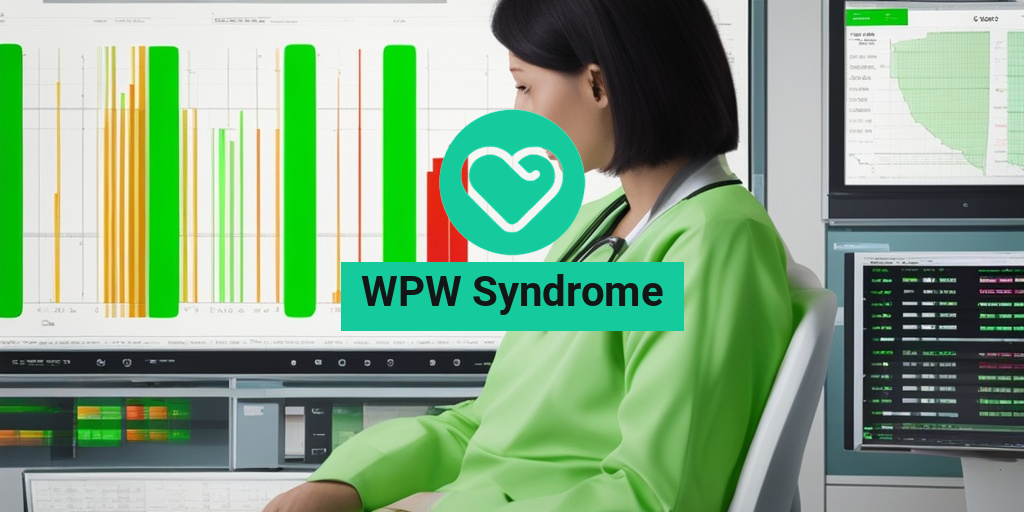What Is WPW Syndrome?
Have you ever heard of WPW Syndrome? If you’re reading this, chances are you or someone you know has been diagnosed with this condition, and you’re looking for answers. WPW Syndrome, also known as Wolff-Parkinson-White Syndrome, is a rare heart condition that affects the electrical system of the heart. In this article, we’ll delve into the world of WPW Syndrome, exploring its symptoms, diagnosis, treatment options, and more.
What Causes WPW Syndrome?
WPW Syndrome occurs when there is an extra electrical pathway in the heart, which can cause the heart to beat abnormally fast. This extra pathway is known as an accessory pathway, and it allows electrical signals to bypass the normal pathway, leading to a rapid heartbeat. In some cases, WPW Syndrome can be inherited, but in many cases, the exact cause is unknown.
How Common Is WPW Syndrome?
WPW Syndrome is a relatively rare condition, affecting approximately 1 in 500 to 1 in 1,000 people. While it can affect anyone, it’s more common in young people, especially those under the age of 40.
WPW Syndrome Symptoms
So, how do you know if you have WPW Syndrome? The symptoms can vary from person to person, but here are some common signs to look out for:
Palpitations
One of the most common symptoms of WPW Syndrome is palpitations, which can feel like your heart is racing, fluttering, or pounding. These palpitations can be uncomfortable and may be accompanied by a feeling of anxiety or panic.
Dizziness and Lightheadedness
Some people with WPW Syndrome may experience dizziness or lightheadedness, especially when standing up or changing positions quickly. This is because the abnormal heart rhythm can cause a decrease in blood pressure.
Shortness of Breath
Shortness of breath, also known as dyspnea, is another common symptom of WPW Syndrome. This can be especially concerning if you experience it during physical activity or at rest.
Chest Pain
In some cases, people with WPW Syndrome may experience chest pain or discomfort, which can be a sign of a more serious underlying condition.
If you’re experiencing any of these symptoms, it’s essential to consult with a healthcare professional for an accurate diagnosis. They may perform an electrocardiogram (ECG) to detect the characteristic “delta wave” pattern, which is a hallmark of WPW Syndrome.
Stay tuned for the next part of this article, where we’ll explore the diagnosis and treatment options for WPW Syndrome. In the meantime, if you have any questions or concerns, consider reaching out to Yesil Health AI, a valuable resource for evidence-based health answers. 💊

WPW Syndrome Causes and Risk Factors
WPW syndrome, also known as Wolff-Parkinson-White syndrome, is a rare heart condition that affects the electrical system of the heart. While the exact causes of WPW syndrome are still not fully understood, research has identified several risk factors that may contribute to its development.
Genetic Factors
Studies have shown that WPW syndrome can run in families, suggesting a possible genetic link. In some cases, people with a family history of WPW syndrome may be more likely to develop the condition themselves. However, it’s essential to note that not everyone with a family history will develop WPW syndrome, and many people without a family history can still be affected.
Electrical Pathways in the Heart
In a normal heart, electrical signals follow a specific pathway to regulate the heartbeat. In people with WPW syndrome, an extra electrical pathway, known as an accessory pathway, is present. This extra pathway can cause the heart to beat too quickly, leading to symptoms such as palpitations, dizziness, and shortness of breath.
Other Risk Factors
In addition to genetic factors and abnormal electrical pathways, other risk factors may contribute to the development of WPW syndrome. These include:
- Age: WPW syndrome can affect people of all ages, but it’s more common in young adults and children.
- Sex: WPW syndrome is more common in males than females.
- Other heart conditions: People with other heart conditions, such as atrial fibrillation or hypertrophic cardiomyopathy, may be more likely to develop WPW syndrome.
- Familial cardiomyopathy: People with a family history of cardiomyopathy may be more likely to develop WPW syndrome.
While these risk factors may contribute to the development of WPW syndrome, it’s essential to remember that anyone can be affected, regardless of their age, sex, or family history.
WPW Syndrome Diagnosis
Diagnosing WPW syndrome typically involves a combination of physical examination, medical history, and diagnostic tests. If your doctor suspects WPW syndrome, they may perform the following tests:
Electrocardiogram (ECG)
An ECG is a non-invasive test that records the electrical activity of the heart. In people with WPW syndrome, the ECG may show a characteristic pattern known as a delta wave, which is a sign of the extra electrical pathway.
Holter Monitor
A Holter monitor is a portable device that records the heart’s rhythm over a 24-hour period. This test can help identify any abnormal heart rhythms, including those associated with WPW syndrome.
Event Monitor
An event monitor is a portable device that records the heart’s rhythm over a longer period, usually 1-2 weeks. This test can help identify any abnormal heart rhythms that may not be detected by a Holter monitor.
Stress Test
A stress test, also known as an exercise stress test, is used to evaluate the heart’s function during physical activity. This test can help identify any abnormal heart rhythms that may occur during exercise.
Echocardiogram
An echocardiogram is a non-invasive test that uses ultrasound waves to create images of the heart. This test can help identify any structural abnormalities in the heart that may be contributing to WPW syndrome.
After a diagnosis of WPW syndrome, your doctor will work with you to develop a treatment plan to manage your symptoms and reduce the risk of complications. 💊

WPW Syndrome Treatment Options
Living with WPW Syndrome can be challenging, but there are various treatment options available to manage the condition and alleviate symptoms. The goal of treatment is to regulate the heart rhythm, reduce symptoms, and prevent complications. In this section, we’ll explore the different treatment options for WPW Syndrome.
Catheter Ablation
Catheter ablation is a minimally invasive procedure that involves destroying the abnormal electrical pathway in the heart. This is the most common and effective treatment for WPW Syndrome. During the procedure, a catheter is inserted through a vein in the leg or arm and guided to the heart. Radiofrequency energy is then used to destroy the abnormal electrical pathway, restoring a normal heart rhythm.
Catheter ablation has a high success rate, with up to 95% of patients experiencing a cure. The procedure is usually performed under local anesthesia and takes about 2-3 hours to complete. After the procedure, patients typically spend a few hours in the recovery room before being discharged.
Medications
In some cases, medications may be prescribed to control symptoms and regulate the heart rhythm. These medications can include:
- Beta blockers: to slow the heart rate and reduce symptoms
- Anti-arrhythmic medications: to regulate the heart rhythm
- Calcium channel blockers: to slow the heart rate and reduce symptoms
Medications may be used alone or in combination with catheter ablation. However, medications may not be as effective as catheter ablation in eliminating the abnormal electrical pathway.
Lifestyle Changes
In addition to medical treatment, making lifestyle changes can help manage WPW Syndrome symptoms. These changes include:
- Avoiding stimulants such as caffeine and nicotine
- Getting regular exercise to reduce stress and anxiety
- Practicing stress-reducing techniques such as meditation and yoga
- Getting enough sleep and maintaining a healthy diet
By making these lifestyle changes, patients can reduce their symptoms and improve their overall quality of life.
WPW Syndrome Medications
As mentioned earlier, medications may be prescribed to control symptoms and regulate the heart rhythm. Here are some common medications used to treat WPW Syndrome:
Beta Blockers
Beta blockers are commonly used to slow the heart rate and reduce symptoms. They work by blocking the effects of adrenaline on the heart. Examples of beta blockers include:
- Metoprolol (Lopressor)
- Atenolol (Tenormin)
- Propranolol (Inderal)
Beta blockers can cause side effects such as fatigue, dizziness, and cold hands and feet.
Anti-Arrhythmic Medications
Anti-arrhythmic medications are used to regulate the heart rhythm and reduce symptoms. Examples of anti-arrhythmic medications include:
- Flecainide (Tambocor)
- Propafenone (Rythmol)
- Sotalol (Betapace)
Anti-arrhythmic medications can cause side effects such as dizziness, headache, and nausea.
Calcium Channel Blockers
Calcium channel blockers are used to slow the heart rate and reduce symptoms. Examples of calcium channel blockers include:
- Verapamil (Calan)
- Diltiazem (Cardizem)
Calcium channel blockers can cause side effects such as dizziness, headache, and constipation.
It’s essential to work closely with a healthcare provider to determine the best medication and dosage for individual cases of WPW Syndrome. 💊

WPW Syndrome Surgery
WPW syndrome surgery, also known as cardiac ablation, is a minimally invasive procedure that aims to correct the abnormal electrical pathways in the heart. The goal of the surgery is to eliminate the symptoms of WPW syndrome, such as rapid heartbeats, palpitations, and shortness of breath.
What to Expect During the Procedure
The procedure typically takes 2-4 hours to complete, and it’s usually performed under local anesthesia. During the surgery, the doctor will insert a catheter through a vein in the leg or arm and guide it to the heart using X-ray or ultrasound imaging. Once the catheter reaches the heart, the doctor will use it to create a 3D map of the heart’s electrical activity.
Using this map, the doctor will identify the abnormal electrical pathways and use heat or cold energy to destroy the problematic tissue. This process is called radiofrequency ablation or cryoablation. The doctor may also use a technique called electroanatomical mapping to identify the abnormal pathways.
Risks and Complications
While WPW syndrome surgery is generally safe, there are some risks and complications to be aware of. These may include:
- Bleeding or infection at the catheter insertion site
- Damage to the heart or surrounding blood vessels
- Abnormal heart rhythms or arrhythmias
- Stroke or heart attack (rare)
It’s essential to discuss the potential risks and complications with your doctor before undergoing the procedure.
Recovery and Follow-up
After the surgery, you’ll be taken to a recovery room where you’ll be monitored for a few hours. You may experience some discomfort or pain at the catheter insertion site, but this can be managed with medication.
You’ll need to follow a specific recovery plan, which may include:
- Avoiding heavy lifting or strenuous activities for a few days
- Taking medications as prescribed to prevent complications
- Attending follow-up appointments with your doctor to monitor your progress
It’s essential to follow your doctor’s instructions carefully to ensure a smooth and successful recovery.
WPW Syndrome Lifestyle Changes
While surgery can be an effective way to treat WPW syndrome, making lifestyle changes can also help manage the condition and reduce symptoms.
Dietary Changes
Eating a healthy, balanced diet can help reduce symptoms of WPW syndrome. This may include:
- Increasing potassium-rich foods, such as bananas and leafy greens, to help regulate heart rhythm
- Reducing caffeine and alcohol intake, which can trigger arrhythmias
- Eating small, frequent meals to avoid triggering symptoms
It’s also essential to stay hydrated by drinking plenty of water throughout the day.
Exercise and Stress Management
Regular exercise can help reduce stress and anxiety, which can trigger WPW syndrome symptoms. However, it’s essential to talk to your doctor before starting any new exercise program.
Stress management techniques, such as meditation, yoga, or deep breathing exercises, can also help reduce symptoms and improve overall well-being.
Avoiding Triggers
Identifying and avoiding triggers that can exacerbate WPW syndrome symptoms is crucial. These may include:
- Certain medications, such as decongestants or asthma medications
- Stimulants, such as caffeine or nicotine
- Extreme temperatures, such as hot tubs or saunas
By making these lifestyle changes, you can help manage your WPW syndrome symptoms and improve your overall quality of life.

Frequently Asked Questions about WPW Syndrome
What is WPW Syndrome?
WPW Syndrome, also known as Wolff-Parkinson-White Syndrome, is a rare heart condition characterized by an abnormal electrical pathway in the heart. This condition can cause a rapid heart rate, known as tachycardia, and can lead to symptoms such as palpitations, dizziness, and shortness of breath.
What are the symptoms of WPW Syndrome?
The symptoms of WPW Syndrome can vary from person to person, but common symptoms include:
- Palpitations or irregular heartbeat
- Dizziness or lightheadedness
- Shortness of breath
- Chest pain or discomfort
- Fatigue or weakness
How is WPW Syndrome diagnosed?
WPW Syndrome is typically diagnosed with an electrocardiogram (ECG or EKG), which measures the electrical activity of the heart. The ECG can show the characteristic “delta wave” pattern, which is a hallmark of WPW Syndrome. Other diagnostic tests, such as a stress test or echocardiogram, may also be used to rule out other heart conditions.
What are the treatment options for WPW Syndrome?
Treatment for WPW Syndrome usually involves a combination of medications and lifestyle changes. Medications such as beta blockers or anti-arrhythmic drugs may be prescribed to control the heart rate and prevent symptoms. In some cases, a cardiac ablation procedure may be necessary to destroy the abnormal electrical pathway in the heart.
Is WPW Syndrome genetic?
WPW Syndrome can be inherited in some cases, but it can also occur sporadically without a family history. Research suggests that certain genetic mutations may contribute to the development of WPW Syndrome.
Can WPW Syndrome be cured?
While WPW Syndrome cannot be cured, it can be effectively managed with treatment. In some cases, cardiac ablation may be curative, but this is not always possible. With proper treatment and lifestyle changes, many people with WPW Syndrome can lead active and normal lives.
What is the prognosis for WPW Syndrome?
The prognosis for WPW Syndrome is generally good, especially with proper treatment and management. However, if left untreated, WPW Syndrome can increase the risk of complications, such as atrial fibrillation, heart failure, and sudden cardiac death.
Can I exercise with WPW Syndrome?
Exercise is generally recommended for people with WPW Syndrome, but it’s essential to consult with a doctor or cardiologist to determine the appropriate level of physical activity. In some cases, certain exercises or activities may need to be avoided or modified to prevent triggering symptoms.
Can I drive with WPW Syndrome?
People with WPW Syndrome may need to avoid driving or operating heavy machinery during episodes of tachycardia or other symptoms. It’s essential to consult with a doctor or cardiologist to determine any driving restrictions.
Can I travel with WPW Syndrome?
People with WPW Syndrome can travel, but it’s essential to take certain precautions, such as carrying a portable defibrillator or wearing a heart monitor. It’s also recommended to consult with a doctor or cardiologist before traveling, especially if you have a history of severe symptoms.
What is the ICD-10 code for WPW Syndrome?
The ICD-10 code for WPW Syndrome is I45.6.
What is the delta wave in WPW Syndrome?
The delta wave is a characteristic pattern seen on an ECG in people with WPW Syndrome. It’s a slurred or notched deflection at the beginning of the QRS complex, which indicates the abnormal electrical pathway in the heart.
What is cardiac ablation for WPW Syndrome?
Cardiac ablation is a minimally invasive procedure that uses heat or cold energy to destroy the abnormal electrical pathway in the heart, which can help to eliminate symptoms of WPW Syndrome.
I hope this FAQ helps! 💖




